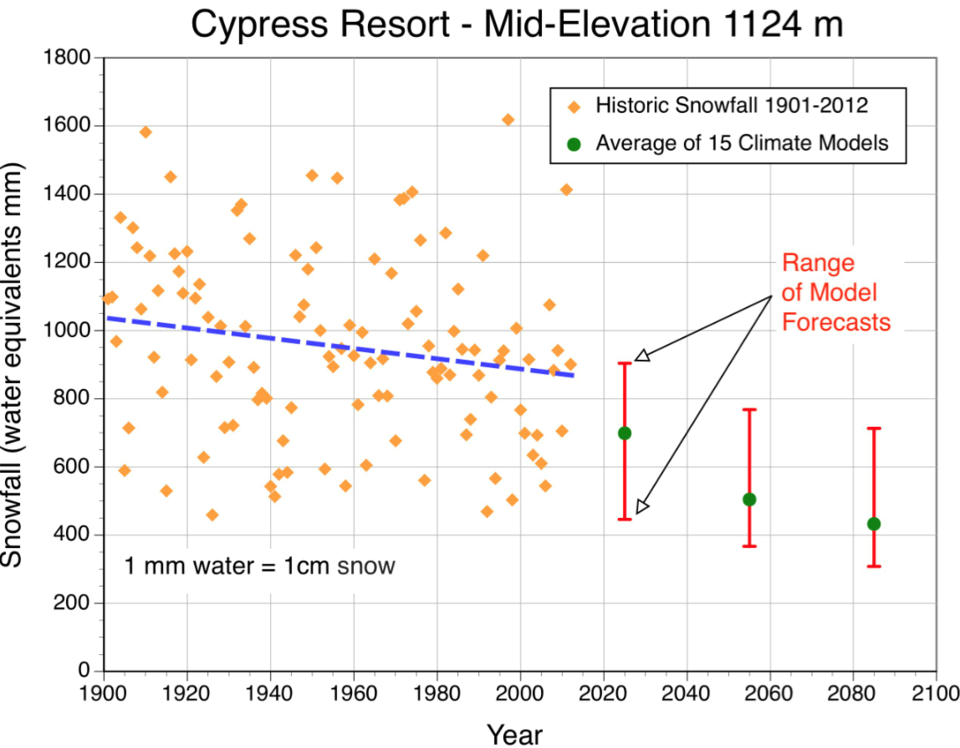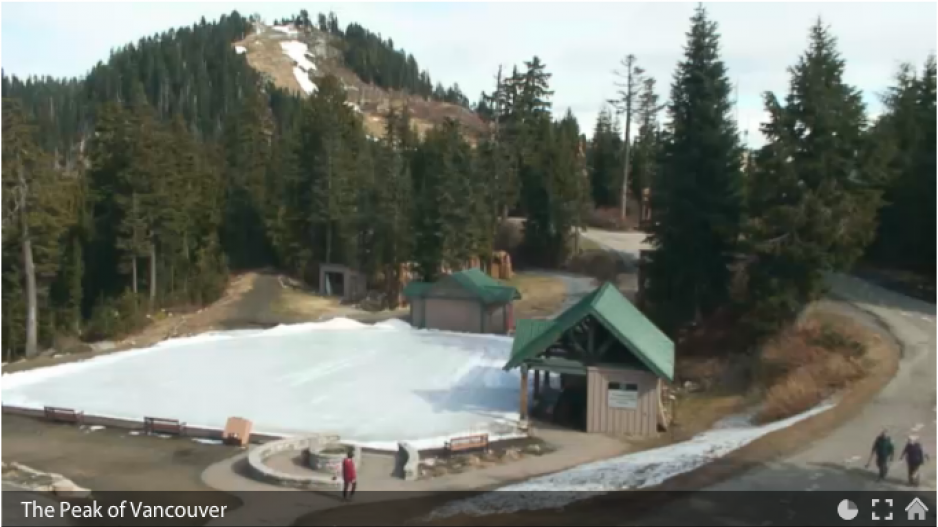In this third instalment in its ongoing climate change series, BIV examines the impact warmer winter temperatures are having on the business of Metro Vancouver ski hills. Previous instalments in the series include Climate change looms as major threat to key B.C. industries and Shrinking timber supply sends B.C. companies on U.S. mill buying spree.
Colder temperatures have finally returned to the Lower Mainland, and ski hills are breathing a sigh of relief.
“It’s definitely one of the warmer ones,” Dave Brownlie, CEO of Whistler Blackcomb (TSX:WB), said of the 2014-15 ski season.
“In my 27 winters here, this would probably be right up there.”
While Whistler Blackcomb’s ski visitor numbers are the same as last year (900,000 visits to date), other resorts haven’t been so fortunate. The North Shore’s lower-elevation ski hills – Grouse, Seymour and Cypress – have had to curtail their seasons. Vancouver Island’s Mount Washington also shut early; Hemlock Resort, near Mission, didn’t open at all.
Those in the ski sector have been stressing that this is an abnormally warm year and shouldn’t be confused with long-term climate trends.
“What we experienced this year was a dramatic increase in temperatures in a short period of time, and that’s driven by cyclical weather patterns,” said David Lynn, president and CEO of the Canada West Ski Areas Association (CWSAA).
“Of course, most of Canada had below-average temperatures.”
Brownlie echoed those comments.
This year’s very warm weather on the West Coast and the unusually cold, snowy weather on North America’s East Coast are both caused by recent changes in the jet stream, a belt of air that travels around the globe, said Michael Pidwirny, an environmental science professor at the University of British Columbia.
It’s not yet known how the jet steam will behave in the future, but some scientists have theorized that climate change could make the jet stream more erratic.
“We might be moving into a new norm for the way that the jet stream behaves and the way that Pacific Ocean temperatures are because of [the] change,” Pidwirny said.
According to climate scientists, ski hills throughout North America will have less snowfall as the century progresses, and B.C. is no exception. But Pidwirny said ski hills could make better use of more accurate forecasting that is being developed.
For instance, with better forecasting, ski hills might choose to invest more in good years and target their marketing.
“In the 1950s, Seymour would have one in 10 bad years. In the last 10 to 20 years, probably three out of 10 are bad,” he said. “The climate models suggest that by 2050, it might be five out of 10 years are bad.”
Pidwirny has used a new software model to develop a historical picture of snowfall on specific B.C. mountains.
The model includes future warming trends based on climate change projections from the Intergovernmental Panel on Climate Change.
There is a lot of variation in climate patterns, so next year might be a good year for ski hills, Pidwirny said. In fact, historical trends suggest that unusually warm years are often followed by very snowy years.
“The future predictions are still a crystal ball and are not as clear as we’d like it,” he said. “What we can probably do is extend the historical trend for the next 10 years.”
He plans to give a presentation at this year’s CWSAA conference in April and hopes the association will agree to fund more research. That’s something Lynn said his organization is considering.

Snowfall has been decreasing over time. The trend (blue dotted line) is expected to continue in the future. Source: Michael Pidwirny, UBC
Pidwirny is taking a closer look at snowfall patterns on Cypress Mountain and Whitewater, a small ski hill near Nelson.
Colby Lehman, manager of outdoor operations for Whitewater, said the ski hill has tracked snowfall since the 1970s. While precipitation has not decreased over time, the amount falling as snow has.
This year, the ski hill delayed opening and initially had to truck snow from its parking lot to cover the base of its lifts. The snow finally came later in the season, and the ski hill hopes to recover some of that lost business during the rest of the season. Whitewater has thus far had 53,000 skier visits compared with 65,000 by this time last year.
Whitewater doesn’t use snow-making equipment, but it’s in the minority. Lynn estimated that more than half of the Alberta and B.C. resorts have invested in the “insurance” of artificial snow. The systems can cost hundreds of thousands of dollars or more, depending on the size of the ski resort. Whistler has 270 snow guns, three reservoirs it can draw from to make snow, and a team of millwrights who work on the system. 
Grouse Mountain has 37 guns and has invested $7 million in snow-making equipment over the past decade, according to Jacqueline Blackwell, manager of public relations for Grouse (see photo at right).
But snow-making wasn’t enough to combat this year’s warm spell.
Grouse, which has the lowest elevation of the North Shore’s three ski hills, closed its ski area in early February. But Blackwell said the temperature has now dropped enough for Grouse to start making more snow. She declined to provide visitor numbers to Business in Vancouver.
Mount Seymour and Cypress Mountain did not respond to interview requests.
Compared with resorts in California and Utah, B.C. has an advantage because it’s farther north and has relatively abundant water supplies for artificial snow-making. Pidwirny said ski hills in the Interior and with higher elevation will be better off than the lower-elevation coastal ski areas.
Whistler Blackcomb is planning to make the most of its high elevation by developing more ski areas in its high alpine.
The resort’s Peak 2 Peak Gondola, which opened in 2008, enables skiers to stay in the high alpine area instead of skiing through the valley, where there might not always be snow, to reach the other mountain.
Diversifying their businesses to include activities like mountain biking or zip lining are other ways ski resorts like Whistler and Grouse are making themselves less vulnerable to downturns.
@jenstden




